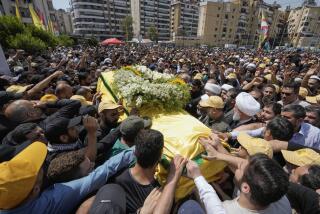Armed with GPS kits, U.S. crew puts the ‘smart’ in smart bombs

Coalition warplanes have dropped more than 10,200 so-called “smart bombs” since President Obama authorized the air war on Islamic State targets in Iraq and Syria last summer.
The use of such “joint direct attack munitions,” the U.S. military says, provides greater accuracy and fewer unintended casualties than explosives not outfitted with GPS antennas or laser control systems.
The fight against the militant Islamist group is the first conflict in which nearly every bomb used by the United States has been guided by satellite or laser; in comparison, about 10% of bombs in the 1991 Persian Gulf War had advanced systems.
The U.S.-led aerial assault nonetheless has yet to push Islamic State out of any of the strongholds it captured last year, including 10 cities in Iraq. And U.S. warplanes are not supporting the Iraqi ground offensive currently aimed at ousting the extremists from Tikrit, in part because Iranian officers and artillery are assisting the Iraqi army and Shiite militias trying to retake the city north of Baghdad.
Attaching GPS-guided tail fin kits isn’t glamorous work, but it’s among the many jobs they do here at this air base in the small Persian Gulf emirate of Qatar. U.S. troops make sure that guidance antennas are linked properly to a computer program to ensure they receive accurate signals.
Airman 1st Class Joshua Miller and 14 others on the so-called ammo team are important cogs in the U.S. military operation. Since deploying here last summer from Dyess Air Force Base in Texas, they have upgraded 2,000 free-falling bombs to “smart bomb” status.
The crew works on a remote stretch of desert at the outer reaches of this sprawling base, operational headquarters for the U.S.-led air war against Islamic State. Their hangar is far from the 8,000 other people who work and live here.
The team initially took an hour to upgrade each 500-pound or 2,000-pound bomb. Now they finish each one in 10 minutes or so.
“When you first start building bombs, your hands are shaking from the nervousness,” said Air Force Tech. Sgt. David Skelton, 31, who oversees the crew. “But that goes away. We went from building nothing to building bombs 12 hours a day.”
A forklift carries the explosives into the hangar from dome-covered facilities, referred to as igloos, where they are stored. The team then swarms like a NASCAR pit crew, affixing a dozen parts – fuses, radar-equipped nose cones, as well as the GPS-guided tail fins to the systems that have been built in St. Louis before being delivered to Qatar for assembly.
“You just develop a rhythm after a while,” Skelton said. “It’s lean manufacturing around here. It’s all part of the assembly line.”
As the airmen work, B-1 bomber jets take off and streak overhead, rattling teeth and equipment alike.
The bomb crews labor six days a week, 12 hours a day. They eat together and share rickety barracks. They endure the 110-degree heat outside.
“We know way too much about one another,” said Master Sgt. Jeremy Luster, 38, who oversees the crew with Skelton.
The pace of attacks is forcing the military to bolster its arsenal.
The Air Force is asking Congress for $559.1 million to buy nearly 20,000 of the bombs for the next fiscal year, according to Pentagon budget documents. Coalition partners have issued orders for thousands more.
Defense giant Boeing Co. plans to more than double its current production to meet the demand.
“The way we’re building now, they’re just rolling off the conveyor belt and going straight to the flight line,” said Luster.
Twitter: @wjhenn
More to Read
Sign up for Essential California
The most important California stories and recommendations in your inbox every morning.
You may occasionally receive promotional content from the Los Angeles Times.










